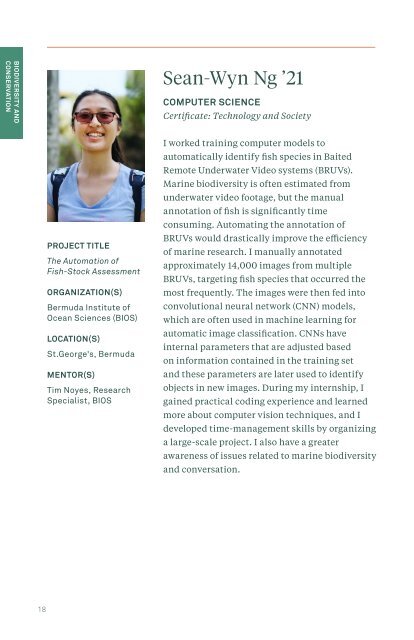Environmental Internship Program - 2019 Booklet
You also want an ePaper? Increase the reach of your titles
YUMPU automatically turns print PDFs into web optimized ePapers that Google loves.
BIODIVERSITY AND<br />
CONSERVATION<br />
Sean-Wyn Ng ’21<br />
COMPUTER SCIENCE<br />
Certificate: Technology and Society<br />
PROJECT TITLE<br />
The Automation of<br />
Fish-Stock Assessment<br />
ORGANIZATION(S)<br />
Bermuda Institute of<br />
Ocean Sciences (BIOS)<br />
LOCATION(S)<br />
St.George's, Bermuda<br />
MENTOR(S)<br />
Tim Noyes, Research<br />
Specialist, BIOS<br />
I worked training computer models to<br />
automatically identify fish species in Baited<br />
Remote Underwater Video systems (BRUVs).<br />
Marine biodiversity is often estimated from<br />
underwater video footage, but the manual<br />
annotation of fish is significantly time<br />
consuming. Automating the annotation of<br />
BRUVs would drastically improve the efficiency<br />
of marine research. I manually annotated<br />
approximately 14,000 images from multiple<br />
BRUVs, targeting fish species that occurred the<br />
most frequently. The images were then fed into<br />
convolutional neural network (CNN) models,<br />
which are often used in machine learning for<br />
automatic image classification. CNNs have<br />
internal parameters that are adjusted based<br />
on information contained in the training set<br />
and these parameters are later used to identify<br />
objects in new images. During my internship, I<br />
gained practical coding experience and learned<br />
more about computer vision techniques, and I<br />
developed time-management skills by organizing<br />
a large-scale project. I also have a greater<br />
awareness of issues related to marine biodiversity<br />
and conversation.<br />
18

















